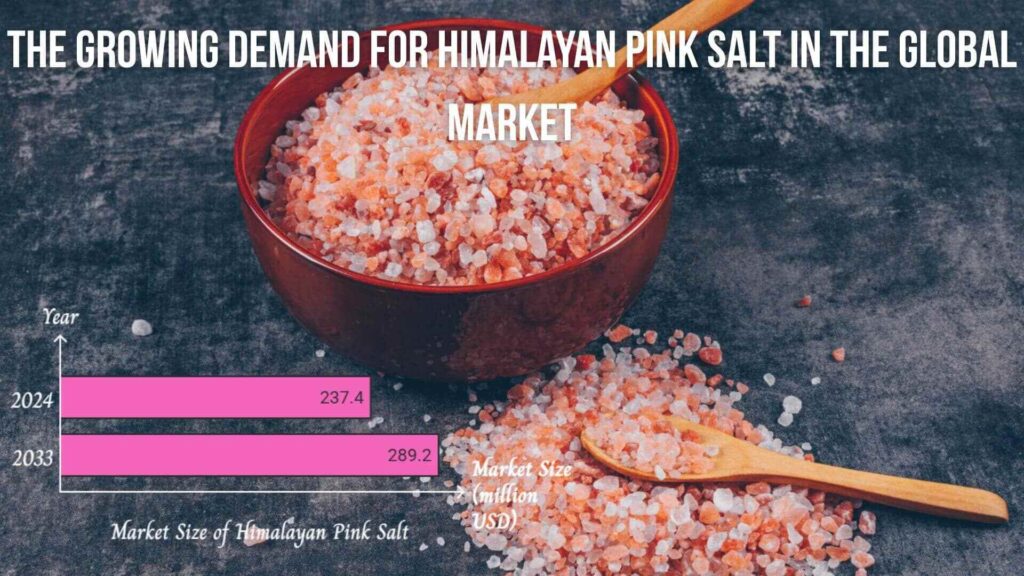The Growing Demand for Himalayan Pink Salt in the Global Market
- Zayan Rauf

The global demand for Himalayan pink salt has grown significantly in recent years. Known for its striking pink color and believed health benefits, this salt has become a popular product across many industries. From wellness centers to restaurants, and even in industrial applications, businesses are recognizing the value of Himalayan pink salt.
But what’s behind this increasing demand? And how are manufacturers like Sobaan Salts meeting the needs of the growing market? In this blog, we’ll look at the health benefits, different uses, and trends surrounding Himalayan pink salt, and discuss how Sobaan Salts is playing a key role in this expanding industry.
Table of Contents
What is Himalayan Pink Salt, and Why Is It So Popular?
Himalayan pink salt is a type of rock salt that comes from the Khewra Salt Mine in Pakistan. It’s famous for its natural pink color and the trace minerals it contains, such as magnesium, calcium, and potassium. These minerals give the salt its unique taste and color.
The growing popularity of Himalayan pink salt can be linked to a few factors:
- The rise of natural and healthy products.
- Increased interest in wellness and self-care.
- The salt’s versatility across different industries, from cooking to wellness products.
Today, Himalayan pink salt is used in kitchens, spas, and even in various industrial applications, making it a valuable product for businesses worldwide.
The Health Benefits of Himalayan Pink Salt

Many people turn to Himalayan pink salt for its potential health benefits. While some of the claims might be exaggerated, this salt does offer several advantages:
- Rich in Essential Minerals
Unlike regular table salt, Himalayan pink salt keeps its natural minerals, such as calcium, magnesium, and iron. These minerals help with electrolyte balance and bone health. - Helps with Hydration
This salt contains important electrolytes, which help keep the body hydrated and maintain fluid balance. - Supports Respiratory Health
Many people use Himalayan salt lamps and salt therapy for respiratory health. These products are believed to help purify the air by releasing negative ions, which may improve air quality. - Better for Blood Pressure
Since Himalayan pink salt has less sodium than regular salt, it is a good choice for people who are trying to control their blood pressure.
These benefits make Himalayan pink salt a popular choice for people who care about their health, making it a valuable product for businesses to offer.
Beyond Food: The Many Uses of Himalayan Pink Salt
While Himalayan pink salt is well-known as a cooking ingredient, its uses go far beyond the kitchen. Let’s explore some of the ways this salt is used in various industries:
- In the Wellness Industry
Himalayan pink salt is a key ingredient in bath salts, scrubs, and other spa products. It’s used for muscle relaxation, detoxifying skin, and promoting relaxation. - In Industry
This salt is also used in water softeners, pool salts, and even as an eco-friendly alternative for de-icing roads during winter months. - In Home Decor
Salt lamps, candle holders, and even cooking blocks made from Himalayan pink salt are popular for their beauty and health benefits. These products are not only decorative but can also help improve indoor air quality.
Himalayan pink salt’s versatility makes it a valuable product for many different industries, adding both aesthetic appeal and wellness benefits.
How Quality Drives the Himalayan Pink Salt Market

As global demand for Himalayan pink salt continues to rise, quality control has become a top priority for suppliers and manufacturers. Whether it’s for culinary, wellness, or industrial use, ensuring consistent purity and safety is critical to success in the salt export business.
What Sets High-Quality Himalayan Pink Salt Suppliers Apart?
1. Rigorous Quality Standards
Reliable manufacturers implement strict quality control processes — from the moment the salt is mined to final packaging. These checks help maintain purity, texture, and mineral integrity across large batches.
2. Technology-Driven Manufacturing
Modern processing technologies improve efficiency while preserving the salt’s natural characteristics. Advanced sorting, washing, and packaging systems contribute to product consistency and safety.
3. Ethical and Sustainable Sourcing
With rising consumer awareness, ethical mining practices and community-centered sourcing have become industry benchmarks. Responsible suppliers support local communities while minimizing environmental impact.
Meeting Global Demand with Reliable Supply Chains
Bulk buyers such as food brands, wellness retailers, and distributors need a dependable supply of Himalayan pink salt. This requires not only consistent product quality but also effective global logistics.
Key capabilities of reliable suppliers include:
- International Distribution Networks to serve markets across North America, Europe, and the Middle East
- Timely Fulfillment of bulk orders, avoiding delays that can disrupt downstream operations
- Custom Manufacturing & White Labeling, allowing businesses to create exclusive product lines under their own brand names.
Emerging Trends in the Himalayan Pink Salt Industry
The market is shaped by growing consumer interest and evolving use cases:
- Health & Wellness Growth
Pink salt is no longer just for the kitchen. It’s gaining popularity in bath salts, spa therapies, and salt lamps, valued for its aesthetic and holistic appeal.
- Culinary Innovation
Chefs and food brands are using salt blocks for grilling, fine grain pink salt in snacks, and even decorative uses in gourmet packaging. The visual and mineral-rich profile of Himalayan salt enhances premium positioning.
- Green Applications
Eco-conscious buyers are now seeking sustainable alternatives to conventional products. Pink salt is increasingly used in eco-friendly de-icing solutions and even in natural pool maintenance.
Read More: Side Effects Of Pink Himalayan Salt Bath What You Need To Know
Sobaan Salts’ Leadership in the Himalayan Pink Salt Market
Sobaan Salts has established itself as a leader in the Himalayan pink salt industry by focusing on quality, innovation, and global distribution. By maintaining high standards, offering custom solutions, and ensuring timely deliveries, Sobaan Salts continues to meet the needs of businesses worldwide.
Himalayan Pink Salt, known for its mineral content and pink hue, is seeing growing demand globally due to health-conscious trends and its use in gourmet cooking and wellness products. Research suggests the market size in 2024 was approximately USD 237.4 million, with projections varying from a 2.22% CAGR to reach USD 289.2 million by 2033 (IMARC Group)
Final Thoughts: The Growing Opportunity in the Himalayan Pink Salt Market
The demand for Himalayan pink salt is on the rise, driven by its health benefits, wide range of uses, and alignment with global wellness trends. Whether it’s for cooking, therapeutic use, or industrial applications, Himalayan pink salt continues to grow in popularity.
Sobaan Salts has positioned itself as a trusted partner for businesses looking to supply high-quality Himalayan pink salt. With a commitment to sustainability, quality, and reliable delivery, Sobaan Salts is ready to meet the growing demands of the market.
Share This Post
Article By

